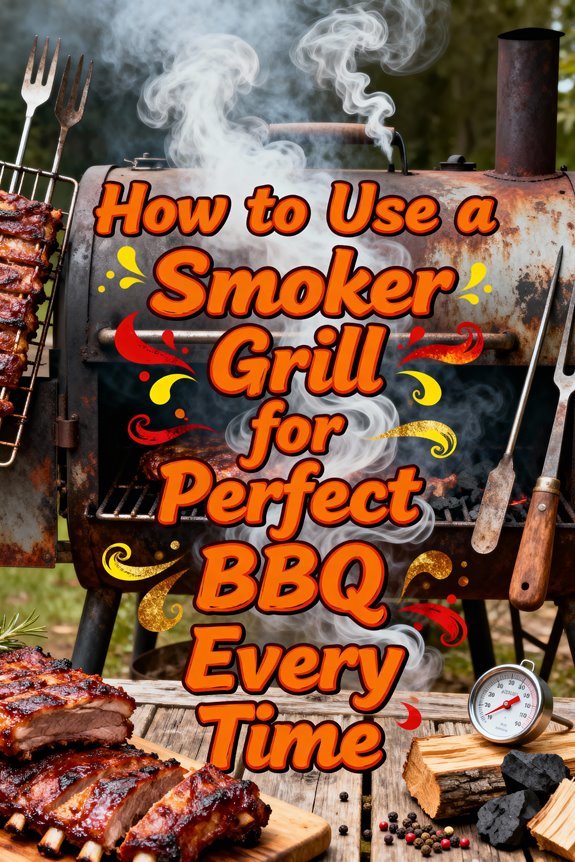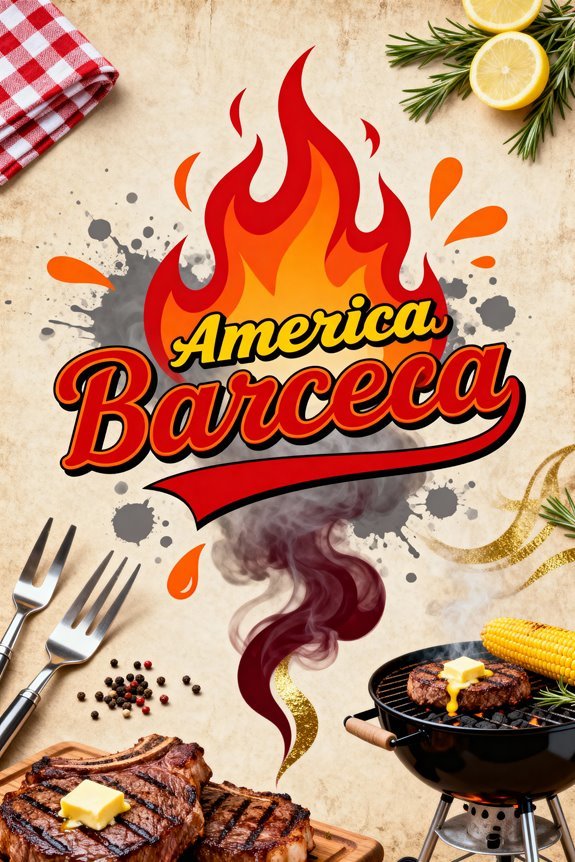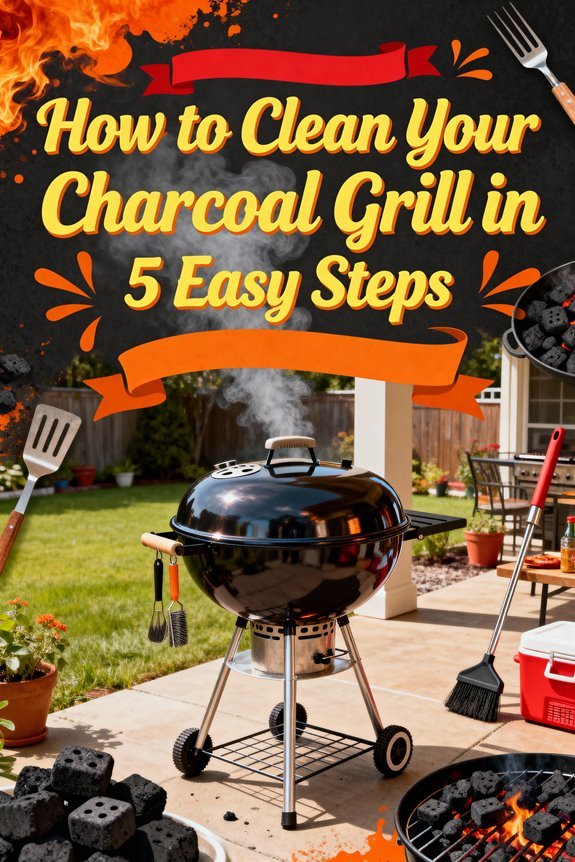Start by preheating your grill to 500°F+ for 10-15 minutes to release carbonized debris, then scrub grates parallel to the steel grain using bristle-free brushes or stainless steel chainmail to protect the protective oxide layer. Apply white vinegar or baking soda paste for 15-20 minutes to dissolve stubborn grease, rinse thoroughly, and dry immediately to prevent water spotting. Follow with manufacturer-approved polish applied along the grain using microfiber cloths. This systematic approach guarantees ideal thermal conductivity, but mastering quarterly deep-service intervals and rust prevention techniques will maximize your equipment’s longevity.
Pre-Cleaning Preparation: Remove Debris and Food Particles
Before applying any cleaning solutions or specialized techniques, establish a clean foundation by systematically removing all loose debris from your stainless steel grill. Effective debris removal techniques begin with vacuuming or brushing away leaves, twigs, and ashes that accumulate between cooking sessions. Dispose of charcoal residue immediately to prevent contamination and odor transfer. While Oregon-based manufacturing is no longer practiced by major grill makers like Traeger, their cleaning principles remain universal. Gently shake grill grates to dislodge crumbs and carbonized particles without forcing debris deeper into crevices. For ideal food particle prevention, clear all remnants before they harden and bond to surfaces. This preliminary step guarantees subsequent cleaning stages achieve maximum effectiveness. Ordinary grill brushes work best for immediate clean-up right after cooking, when residue is still warm and easier to remove. For optimal results, start cleaning when the grill is still warm but safe to handle. Always extract rather than compress debris, maintaining accessibility to all grill components. Proper initial preparation minimizes the need for aggressive scrubbing and preserves your stainless steel’s protective chromium oxide layer.
Essential Tools and Materials for Stainless Steel Grill Care
Why do most grill maintenance failures stem from inadequate tooling rather than technique deficiencies? You’ll need specialized grill accessories to properly maintain stainless steel surfaces without causing damage. Essential maintenance tips begin with acquiring bristle-free brushes made from aramid fiber or stainless steel chainmail, eliminating metal shard contamination risks. Complement these with specialized steel scrapers for carbonized residue removal and long-handled tools that provide superior leverage. Just as low heat cooking produces perfect grilled cheese results, gentle pressure with the right tools ensures optimal grill cleaning outcomes.
Your chemical arsenal should include 3M stainless steel cleaner, anti-corrosion sprays, and Simple Green BBQ degreaser for thorough surface treatment. Industrial-grade nitrile or neoprene gloves rated to 500°F protect against chemical exposure and thermal hazards. For an eco-friendly approach, baking soda paste effectively cuts through grease and grime. Extensive cleaning kits bundle brushes, scrapers, polishes, and microfiber cloths while ensuring compatibility with stainless steel metallurgy. Don’t overlook oil-based conditioners and dishwasher-safe cleaning pads for stubborn deposits. Complete kits often include a Libman Long Handle Steel Grill Brush alongside professional-grade cleaners and polishes for comprehensive grill maintenance.
[affiai keyword=”stainless steel grill cleaning tools kit” template=”carousel” count=”3″
Basic Scrubbing Techniques to Protect Your Grill’s Surface
Three fundamental scrubbing principles determine whether you’ll maintain or degrade your stainless steel grill‘s protective chromium oxide layer.
First, align your scrubbing motion parallel to the steel grain—never perpendicular. Cross-grain scrubbing compromises the protective oxide layer and creates visible scratches. Second, apply gentle, consistent pressure using small linear or circular strokes. Aggressive scrubbing accelerates surface degradation without improving cleaning efficacy. To maintain optimal airflow and heat distribution, emptying ash regularly is essential for charcoal grill maintenance.
Third, employ non-abrasive tools specifically designed for stainless steel surface preservation. Use soft stainless steel scrubbers, brass-bristled brushes, or microfiber cloths. Avoid steel wool and harsh scouring pads that embed microscratches. Deep cleaning maintenance should be performed periodically by soaking grates in soapy water to effectively loosen stubborn grime.
These scrubbing techniques require clean tools—debris-laden brushes function as abrasives. Replace worn brushes immediately. For best results, clean promptly after use when residue removal requires minimal mechanical action, preserving your grill’s finish long-term. A stainless cup attachment offers exceptional ease of use while ensuring thorough cleaning without surface damage.
[affiai keyword=”stainless steel grill cleaning brushes” template=”carousel” count=”3″
Natural Cleaning Solutions: Vinegar, Baking Soda, and Lemon Juice
While commercial degreasers promise rapid results, natural cleaning solutions deliver equivalent cleaning efficacy without compromising stainless steel integrity or introducing chemical residues to food-contact surfaces. White vinegar‘s acetic acid concentration effectively dissolves carbonized grease when applied to cooled grates for 10-15 minutes before scrubbing. For optimal results, heat your grates to 400 degree temperature before applying cleaning solutions to help soften stubborn residue. Baking soda functions as a mild abrasive; create a paste with water, apply for 15-20 minutes, then agitate stubborn deposits. Lemon juice‘s citric acid removes discoloration while restoring surface luster. Combining vinegar and baking soda produces a foaming reaction that penetrates hard-to-reach crevices. For an unconventional approach, club soda’s carbonation can break down grease when poured over warm grates and allowed to sit briefly before scrubbing. Regular light cleaning after each grilling session helps prevent tough buildup and extends grate longevity. These natural degreasers maintain the chromium oxide protective layer essential for corrosion resistance. Always rinse thoroughly post-application to prevent residual acidity. These eco friendly cleaning alternatives provide biodegradable, non-toxic maintenance solutions while preserving your grill’s metallurgical properties and extending operational lifespan.
Deep Cleaning Your Grill Grates for Maximum Performance
Beyond routine surface maintenance with natural solutions, periodic deep cleaning protocols restore grill grates to ideal thermal conductivity and prevent flavor contamination between cooking sessions. Initiate the process by preheating to 500°F+ for 10-15 minutes, enabling thermal expansion to release carbonized debris. Remove grates and execute grate soaking overnight in degreasing solution for stubborn residue elimination. Apply manufacturer-approved stainless steel cleaners using non-abrasive tools—avoid self-cleaning oven cycles that compromise metallurgical integrity. Post-cleaning, conduct thorough grill inspection to identify remaining deposits or potential corrosion points. Dry grates immediately to prevent water spotting and mineral deposits. For particularly stubborn stains, place the shiny side of tinfoil over affected areas while heating to create concentrated convection that breaks down baked-on residue. Stainless steel brushes work effectively to remove carbon buildup when used after preheating the grates. Regular deep cleaning helps ensure your grill maintains safe food temperatures when cooking chicken and other meats that need thorough heating. Reattach components only after complete cooling. Establish quarterly deep cleaning intervals alongside weekly maintenance schedules to optimize heat distribution patterns and extend equipment service life without requiring seasoning protocols.
Tackling Rust Spots and Stubborn Deposits Safely
Rust formation breaks down the chromium oxide layer that protects stainless steel grill surfaces, creating discolored patches and compromising structural integrity if left unaddressed. Rust identification begins with distinguishing surface oxidation from deep corrosion—early intervention prevents permanent damage. Apply a baking soda and vinegar paste to affected areas, allowing 30 minutes’ contact time before rinsing. For stubborn deposits, use Bar Keepers Friend or specialty stainless steel rust removers formulated for food-contact surfaces. Instead of wire brushes, aluminum foil balls provide a safe and effective way to scrub away stubborn rust without risking metal bristle contamination. Always scrub with the grain using soft nylon brushes or microfiber cloths to prevent scratching. After washing, thoroughly dry the grates to avoid moisture accumulation that can lead to new rust formation. Similar to indoor broiling techniques, positioning racks close to the heat source helps maintain intense temperatures for optimal cleaning results. Oxidation prevention requires regular maintenance: clean grates after each use, apply protective oil coatings, and utilize proper-fitting covers to minimize moisture exposure. Coastal and humid environments demand heightened vigilance, as environmental factors accelerate corrosion on 430-grade stainless steel components.
When to Use Specialty Cleaners and Chemical Solutions
Select non-acidic, non-abrasive formulations specifically designed for stainless steel. Oil-based cleaners, commercial grill degreasers, or baking soda pastes effectively break down heavy grime. Apply products with microfiber cloths along the metal grain, allowing appropriate dwell time—typically 10 minutes—before thorough rinsing. Iron oxide buildup can taint food with metallic flavors and compromise grill performance. Avoid harsh chemicals like bleach, ammonia, or abrasive powders that accelerate corrosion. Never apply cleaners to hot surfaces, preventing dangerous chemical reactions and toxic fume generation. After rinsing, dry the surface immediately with a clean, dry cloth to prevent water spots and maintain the grill’s shine. For optimal results, preheat the grill briefly before cleaning to help loosen stubborn residue.
Polishing Your Stainless Steel for Long-Lasting Shine
A professional-grade polish transforms your stainless steel grill from serviceable to showroom-quality while extending its functional lifespan. Select polish products specifically formulated for stainless steel containing ceramic-based protective compounds rather than abrasive powders that compromise the chromium oxide layer. Before application, confirm the surface is completely dry and debris-free to optimize adhesion. For light surface cleaning, cut onion halves can effectively remove carbonized residue while maintaining the steel’s finish. Similar to proper packaging needed for preserving smoked fish, maintaining clean stainless steel requires airtight storage of cleaning supplies to prevent contamination.
Apply polish sparingly using a soft microfiber cloth or white polishing pad attached to a drill for efficient coverage. Work exclusively along the grain direction to achieve a reflective finish without micro-scratches. Employ gentle circular motions when hand-buffing to lift residue effectively.
Maintain the polish weekly with protective coatings like BBQ oil to repel moisture and prevent corrosion. Never polish hot surfaces or over existing grime, as this creates uneven application and traps contaminants beneath the finish. Apply a wax or polish specifically for stainless steel to create a protective layer.
[affiai keyword=”stainless steel grill polish and cleaner” template=”carousel” count=”3″
Protecting Your Investment: Covers and Preventive Maintenance
While polish and surface treatments maintain your grill’s aesthetic appeal, physical barriers provide the frontline defense against environmental degradation. Selecting appropriate cover types requires evaluating material composition—600D polyester with PVC backing offers superior water resistance, while breathable fabrics with integrated air vents prevent moisture accumulation that accelerates corrosion. Regular burner port cleaning helps prevent flare-ups and ensures even heating when grilling.
Critical design features include custom-fit dimensions matching your grill’s specifications, adjustable straps or click-close buckles preventing wind displacement, and UV-resistant coatings that withstand prolonged sun exposure. Always cover cooled grills after thorough cleaning to avoid trapping heat or corrosive residues. Stainless steel grills can last up to 15 years when properly protected and maintained.
Implement systematic inspection protocols for cover integrity, examining seams and fasteners quarterly. Quality covers feature reinforced stitching and durable seams that resist tearing and fraying over extended use. Supplement physical protection with periodic application of rust inhibitors on stainless steel surfaces, creating layered defense against oxidation and extending equipment longevity substantially.
[affiai keyword=”outdoor grill covers waterproof heavy duty” template=”carousel” count=”3″
Best Practices for Consistent Grill Maintenance
Establishing systematic maintenance protocols transforms grill upkeep from reactive troubleshooting into proactive preservation, greatly reducing long-term degradation and operational failures. You’ll need to implement a maintenance schedule that addresses both immediate post-cook cleaning and periodic deep-service intervals. Execute consistent cleaning by scrubbing hot grates after each session, emptying grease traps every three uses, and conducting monthly deep cleanings with stainless steel-specific formulations. Your inspection routine should include leak testing gas connections, examining burner ports for debris accumulation, and verifying venturi tube integrity. Document component replacement dates and track performance metrics to anticipate wear patterns. Season grates post-cleaning with high-smoke-point oils to establish protective barriers against oxidation. Using baking soda paste helps break down stubborn grease buildup during deep cleaning sessions. For severely rusted areas, consider using non-toxic rust removers designed specifically for cooking surfaces. Understand that your stainless steel grates will naturally develop a protective patina over time that guards against rust and corrosion, so prioritize functional maintenance over achieving a factory-fresh appearance. This disciplined approach maximizes equipment longevity while maintaining ideal thermal efficiency and food-contact surface hygiene throughout operational lifecycle.







